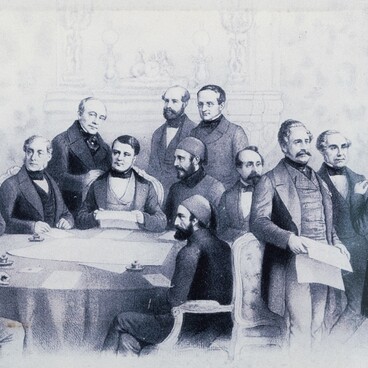The medal “In memory of the war of 1853–1856” was a popular award in the Russian Empire. It was awarded both to the participants in the Crimean (Eastern) War and to those who were in the rear.
The design of the medal was created and approved on March 30, 1856. Later, in August of the same year, Emperor Alexander II, on the occasion of his coronation, officially established it in a special manifesto “On the All-Merciful Granting of Blessings to the People on the Occasion of the Crowning of His Imperial Majesty”.
The medals were all minted in a size of 28 millimeters, but in two color variations — light bronze and dark bronze. The collection of the museum contains the light bronze medal.
The obverse depicted the monograms of emperors Nicholas I and Alexander II, wearing imperial crowns. Above them were the rays of the “eye of providence”, and under, along the medal’s rim were the dates “1853-1854-1855-1856”. On the reverse side of the medal, a horizontal inscription was minted in five lines — a quote from the Old Testament which meant “O my God, I trust in thee: let me not be ashamed.”
The medal was worn on the chest or in the buttonhole. For this, a special eyelet hole was cast at the top, which was used to attach the award to a metal suspension device or four order ribbons. Usually, the light bronze medals were worn on the St. Andrew, St. George or St. Vladimir ribbons, and from dark bronze — on the St. Vladimir or St. Anna ones.
Light bronze medals were primarily awarded to war participants. On the St. George ribbon, it was worn by employees of all military units that operated in the Caucasus and the Danube region, as well as participants in the Battle of Sinop and defenders of the Petropavlovsk port in Kamchatka.
The same medal, only on the St. Andrew ribbon, was awarded to everyone who participated in significant battles but did not receive a medal on the St. George ribbon. They also marked the state militias, the lower ranks of the Little Russian Cossack regiments who participated in the battles, and the nurses, who were in combat positions during the war and treated wounded soldiers.
The dark bronze medal on the St. Vladimir ribbon was given to all military ranks who were in the civil service during the war, and even to the eldest members of the Russian noble families. However, the latter had no right to wear the medal — they only kept it in memory of the war. The dark bronze medals on the St. Anna ribbon were received by merchants and wealthy honorary citizens, ”… who distinguished themselves by donations for the costs of the war or benefits to the wounded and families of the killed.” Upon the death of those who were awarded, their medals were inherited by descendants, but again with no right to wear them.
The design of the medal was created and approved on March 30, 1856. Later, in August of the same year, Emperor Alexander II, on the occasion of his coronation, officially established it in a special manifesto “On the All-Merciful Granting of Blessings to the People on the Occasion of the Crowning of His Imperial Majesty”.
The medals were all minted in a size of 28 millimeters, but in two color variations — light bronze and dark bronze. The collection of the museum contains the light bronze medal.
The obverse depicted the monograms of emperors Nicholas I and Alexander II, wearing imperial crowns. Above them were the rays of the “eye of providence”, and under, along the medal’s rim were the dates “1853-1854-1855-1856”. On the reverse side of the medal, a horizontal inscription was minted in five lines — a quote from the Old Testament which meant “O my God, I trust in thee: let me not be ashamed.”
The medal was worn on the chest or in the buttonhole. For this, a special eyelet hole was cast at the top, which was used to attach the award to a metal suspension device or four order ribbons. Usually, the light bronze medals were worn on the St. Andrew, St. George or St. Vladimir ribbons, and from dark bronze — on the St. Vladimir or St. Anna ones.
Light bronze medals were primarily awarded to war participants. On the St. George ribbon, it was worn by employees of all military units that operated in the Caucasus and the Danube region, as well as participants in the Battle of Sinop and defenders of the Petropavlovsk port in Kamchatka.
The same medal, only on the St. Andrew ribbon, was awarded to everyone who participated in significant battles but did not receive a medal on the St. George ribbon. They also marked the state militias, the lower ranks of the Little Russian Cossack regiments who participated in the battles, and the nurses, who were in combat positions during the war and treated wounded soldiers.
The dark bronze medal on the St. Vladimir ribbon was given to all military ranks who were in the civil service during the war, and even to the eldest members of the Russian noble families. However, the latter had no right to wear the medal — they only kept it in memory of the war. The dark bronze medals on the St. Anna ribbon were received by merchants and wealthy honorary citizens, ”… who distinguished themselves by donations for the costs of the war or benefits to the wounded and families of the killed.” Upon the death of those who were awarded, their medals were inherited by descendants, but again with no right to wear them.



